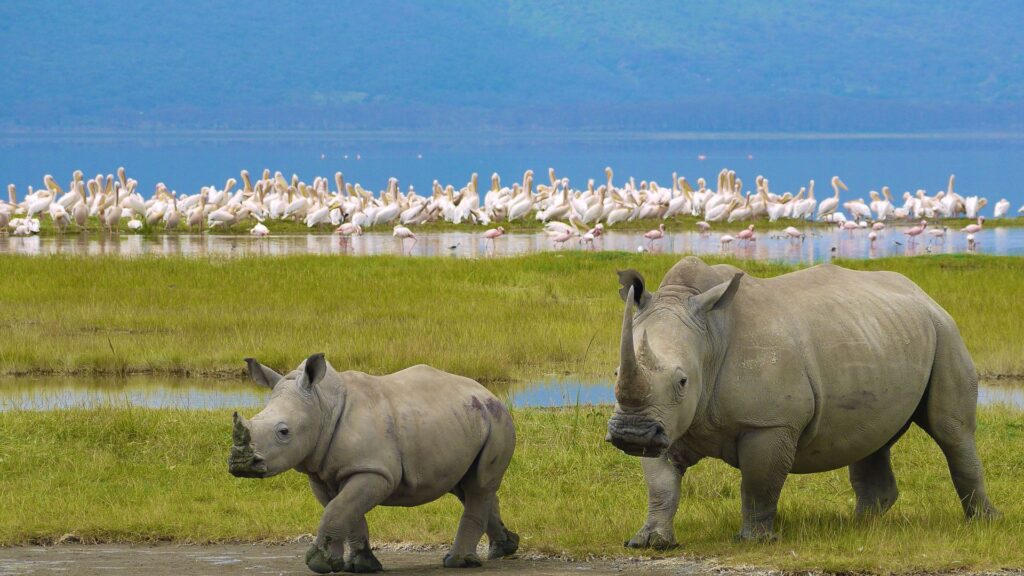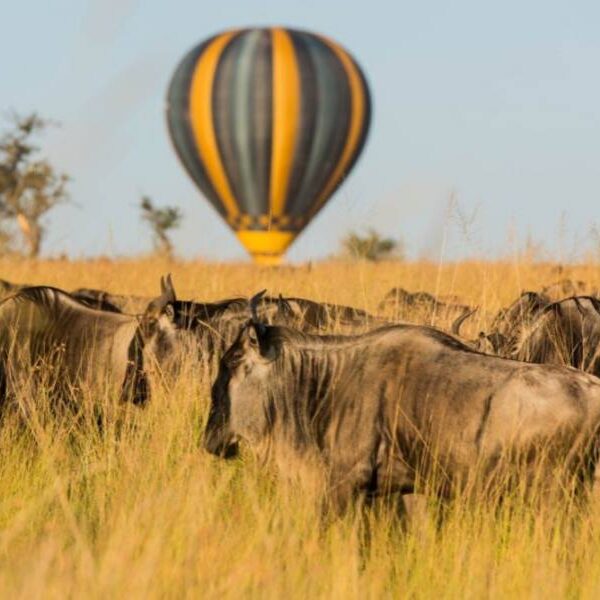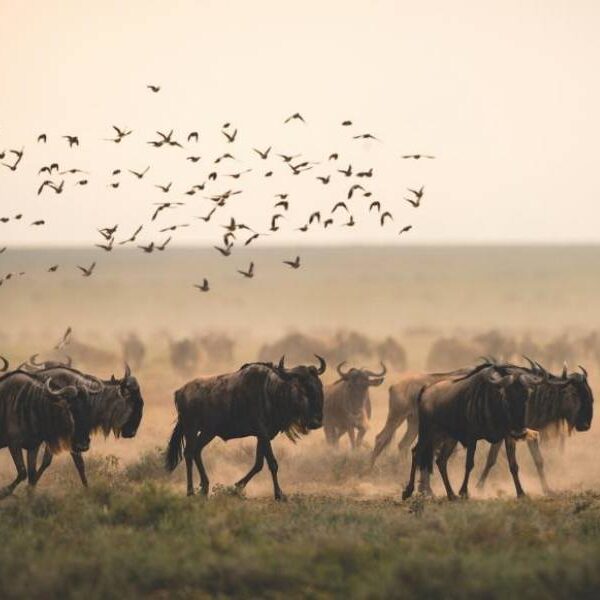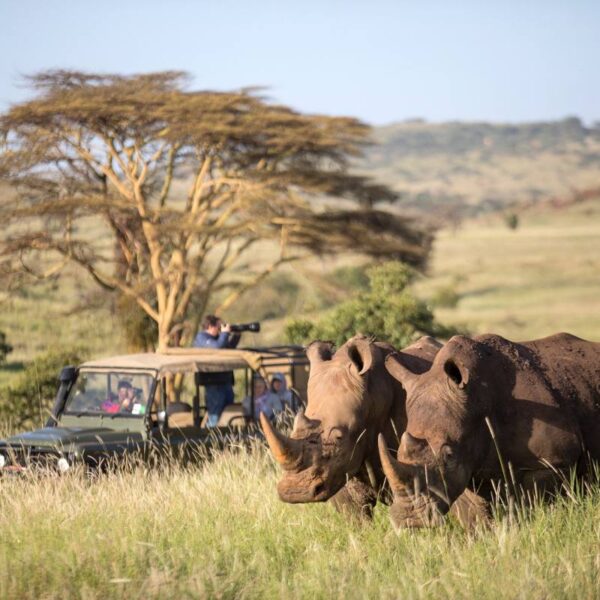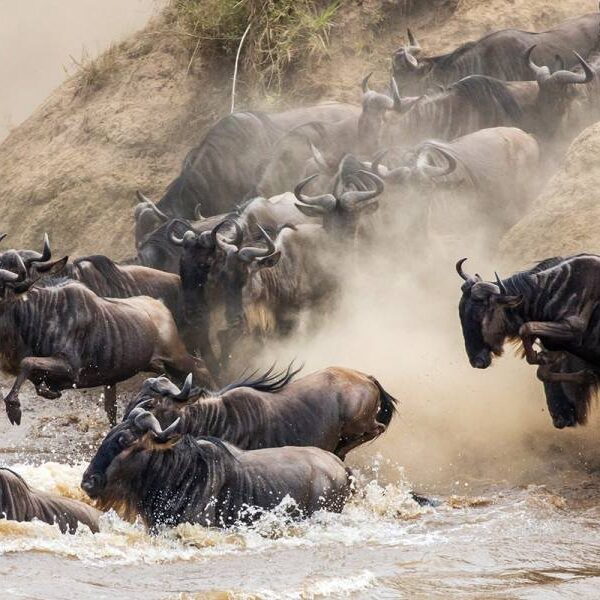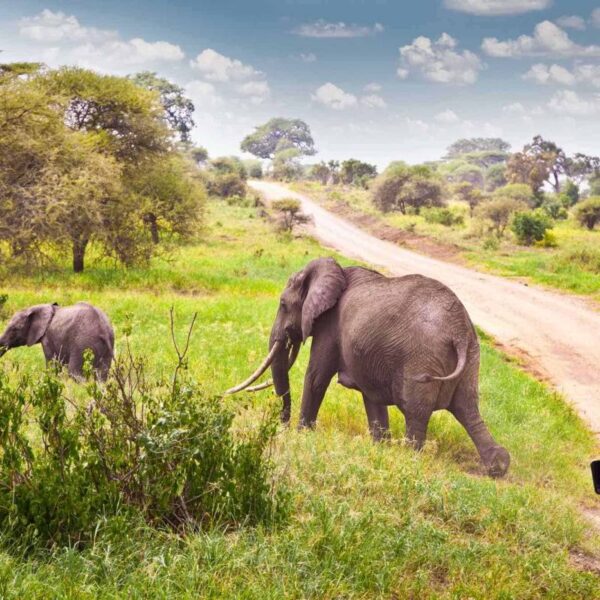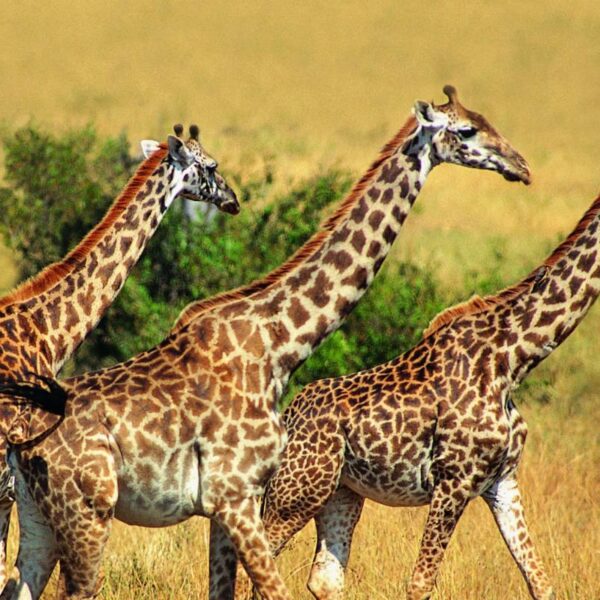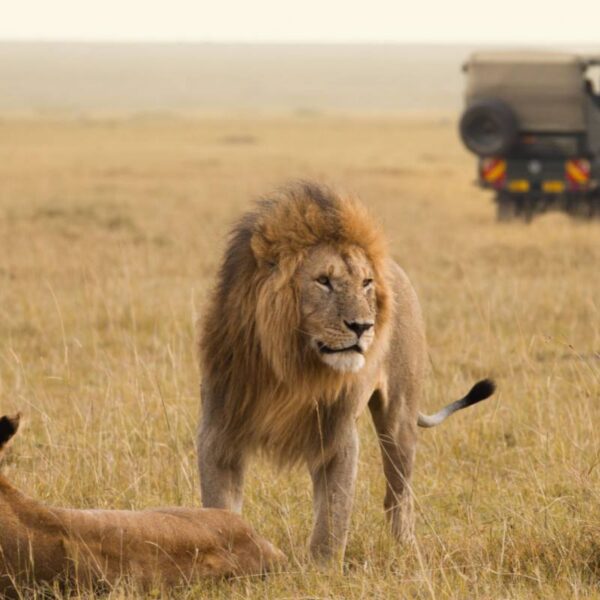Amboseli National Park
It is the second most popular national park in Kenya after Masai Mara. Located 240 kilometers/150 miles south of Nairobi, it lies directly on the Kenya/Tanzania border, at the foot of the highest mountain in Africa, Mount Kilimanjaro in Tanzania. A system of swamps makes Amboseli one of the best wildlife-viewing experiences in the world.
It is renowned for the large herds of free-ranging African elephants that are easy to see and photograph due to the flat and naked terrain. Amboseli’s elephants, which are said to be among the biggest in the country, are fond of the swamps. Other animals on view are Cape buffalo, impala, lion, cheetah, black rhino, spotted hyena, jackal, giraffe, zebra, and wildebeest. Bird watchers have 400 species of birds to watch for.
Lake Nakuru National Park
On the floor of the Great Rift Valley, surrounded by wooded and bushy grassland, lies the beautiful Lake Nakuru National Park. Visitors can enjoy the wide ecological diversity and varied habitats that range from Lake Nakuru itself to the surrounding escarpment and picturesque ridges. Lake Nakuru National Park is ideal for bird watching, hiking, picnic and game drives.
Attractions
- Flamingo (Greater and Lesser) and other water birds including a variety of terrestrial birds numbering about 450 species in total.
- Mammals: 56 different species including white rhinos, waterbuck etc.
- View-points: Lion hill, Baboon cliff and Out of Africa
- Hills: Enasoit, Honeymoon, Lion hill ridge etc.
- Waterfalls: Makalia.
- Unique vegetation: About 550 different plant species including the unique and biggest euphorbia forest in Africa, Picturesque landscape and yellow acacia woodlands.
- Cycle with rhino event every September yearly
The Mount Kenya National Park
This is home to Africa’s second-highest mountain, Mount Kenya. It is also an amazing place for animal and bird viewing. The park has been recognized as a UNESCO World Heritage site. Mount Kenya is a forest reserve in which a number of animal species reside. There are at least 160 bird species that exist with 53 of Kenya’s 67 African biome bird species including the rare and threatened Abbott’s Starling. The park is also home to several species of eagles that sometimes soar high above.
Samburu National Park
It is the wildlife reserve made famous by Joy Adamson, the naturalist, artist, and author of the book, “Born Free” which describes her experiences raising a lion cub. It is also one of the 56 protected areas in Kenya which came into being, due in part to the generous assistance given by several individuals and foundations. There is a wide variety of animal and birdlife to be viewed. Several large game species common to Kenya’s northern plains can be found in abundance here including the gerenuk, Grevy’s zebra, oryx, and reticulated giraffe. All three big cats, Masai lion, Tanzanian cheetah, and leopard, can also be found here, as well as elephants, buffalo, and hippos. Samburu is a paradise for bird lovers with over 350 species of birds recorded.
Aberdare National Park
The park is characterized by picturesque, steep forested ravines and open moorland characterize . It provides a habitat for elephants, black rhinos, leopards, spotted hyenas, olive baboons, black and white colobus monkeys, buffalos, warthogs and bushbucks among others. Rare sightings include those of the Giant Forest hog, bongo, golden cat, serval cat, African wild cat, African civet cat and the blue duiker. Visitors can indulge in picnics, trout fishing in the rivers and camping in the moorlands. Bird viewing is rewarding, with over 250 species of birds in the park, including the Jackson’s Francolin, Sparrow hawks, goshawks, eagles, sunbirds and plovers.
Attractions
- Game animals easily seen in the park during game viewing include; African Elephant, black rhino, leopard, spotted hyena, olive baboon, black and white colobus monkey, sykes monkey, cape buffalo, warthog, common zebra (North Aberdare), bushbuck, reedbuck. Rare sightings include those of Giant Forest hog, bongo, golden cat, serval cat, African wild cat, African civet cat, blue duiker.
- Very beautiful sceneries of Aberdare include magnificent waterfalls with the main ones being Karuru waterfalls which fall in three steps, 1st step 117M, 2nd step 26M and 3rd 130M, making a total of 273M, Chania waterfalls and may other smaller ones.
- Adding to the beauty of Aberdare are many ridges and river valleys which attract mountain scenery photographers.
- A recent marked attraction in Aberdare is the 400Kms electric fence which was completed – final post on 28th August, 2009. The fence protects the whole Aberdare ecosystem from human pressures and contains wildlife, preventing human/wildlife conflict.
- Visitors can also indulge in picnics, trout fishing (in the past the rivers were stocked with brown rainbow trout) in the rivers and camping in the Moorlands. Bird viewing is rewarding with about 290 recorded bird species, including the Aberdare Cisticola that is critically endangered and the Jackson’s francolin, which is regionally endemic, sparry hawk, goshawks, eagles, sunbirds and plovers
Nairobi National Park
A short drive out of Nairobi’s central business district is the Nairobi National Park. Wide open grass plains and backdrop of the city scrapers, scattered acacia bush play host to a wide variety of wildlife including the endangered black rhino, lions, leopards, cheetahs, hyenas, buffaloes, giraffes and diverse birdlife with over 400 species recorded. Visitors can enjoy the park’s picnic sites, three campsites and the walking trails for hikers.
Attractions
- The only Wildlife park in the world that is so close to the city
- Black rhinoceros :which is an endangered species
- The first park to be gazetted in Kenya on December 16, 1946
- Major rhino sanctuary for breeding and restocking other parks
- Diverse birdlife:Has over 400 bird species. At least 20 of which are seasonal European migrants.
- Home to over 100 mammal species, four of the Big Five (lion, Buffalo, leopard and rhino)
- Has a spectacular wildebeest and zebra migration
- Large predators- lion, leopard, hyena and cheetah.
- Aggregations of large herbivores- eland, buffalo, zebra and wildebeest
- Ivory Burning Site Monument
- Walking trails at hippo pools
- Nairobi Safari Walk & the Orphanage.
- Spacious accommodating picnic sites
Samburu National Reserve
The Samburu National Reserve is a game reserve on the banks of the Ewaso Ng’iro river in Kenya. On the other side of the river is the Buffalo Springs National Reserve. The park is 165 km² in size and is situated 350 kilometers from Nairobi. It ranges in altitude from 800 to 1230 m above sea level.[1] Geographically, it is located in Samburu County.
In the middle of the reserve, the Ewaso Ng’iro flows through doum palm groves and thick riverine forests. It provides water, without which the game in this arid region could not survive.
The Samburu National Reserve was one of the two areas in which conservationists George and Joy Adamson raised Elsa the Lioness, made famous in the best-selling book and award-winning movie Born Free. The Elephant Watch Camp, of which Saba Douglas-Hamilton is director, lies within the park.
The Samburu National Reserve is also the home of Kamunyak, a lioness famous for adopting oryx calves.
Tsavo East National Parks
Also known as the Theatre of the Wild. It is a sight of dust-red elephant wallowing, rolling and spraying each other with the midnight blue waters of palm-shaded Galana River is one of the most evocative images in Africa. This, along with the 300 kilomtere long Yatta Plateau, the longest lava flow in the world, make for an adventure unlike any other in the Tsavo East. The park forms the largest protected area in Kenya and is home to most of the larger mammals, vast herds of dust –red elephant, Rhino, buffalo, lion, leopard, pods of hippo, crocodile, waterbucks, lesser Kudu, gerenuk and the prolific bird life features 500 recorded species.
Tsavo West National Park
Known as the Land of Lava, Springs, Man-Eaters & Magical Sunsets
From the sight of fifty million gallons of crystal clear water gushing out of from the under parched lava rock that is the Mzima Springs to the Shetani lava flows, Tsavo West is a beautiful, rugged wilderness. The savannah ecosystem comprises of open grasslands, scrublands, and Acacia woodlands, belts of riverine vegetation and rocky ridges including the Poacher’s Lookout where visitors can see the teeming herds in the plains below. Tsavo West offers some of the most magnificent game viewing in the world and attractions include elephant, rhino, Hippos, lions, cheetah, leopards, Buffalos, diverse plant and bird species including the threatened corncrake and near threatened Basra Reed Warbler.
Attractions
- The spectacle Mzima Springs is the sight of fifty million gallons of crystal clear water gushing out of from the under parched lava rocks, forming the most welcoming and lovely scene in Africa
- Ancient lands of Lions, in 1898 the Uganda railway construction was abruptly halted by the two of the most voracious and insatiable man-eating lions appeared upon the scene, and for over nine month waged intermittent warfare against the railway and all those connected with it in the vicinity of Tsavo.
- A vibrant volcanic arena; molten lava that form Shetani lava spewed from the earth just about 200 years ago and its fiery fury was thought by locals to be work of the Devil.
- Poacher’s Lookout and roaring rocks; the Park abound the panoramic vintage point from which to view the movement of the herds.
- Glorious game drives; Tsavo west offers some of the most magnificent game viewing in the world
- Ngulia Sanctuary; this is where the growing population of highly endangered black rhino are inching from chasm of extinction forced upon them by rampant poaching in the 1960s.
- Lake Jipe, lies astride Kenya and Tanzania boarder and is teeming with aquatic life, Bird watching I also major activity around the lake.
- First World War Site-East African Campaign, Perhaps the most bizarre campaign of the world war was fought in the “Bundu” (Bush) – the barely explored wilderness of thorny scrub and dense forest of Tsavo west. This last ‘gentleman war’ was waged under the code of honor-sometimes; or under guerilla tactics adopted from African tribal fighters. The Guided tours of the Crater, Kichwa Tembo and Mzima fort will enable you trail the real footsteps of the world war veterans.
Hells Gate National Park
“A Walk on the Wild Side”
Named for the intense geothermal activity within its boundaries, the Hell’s Gate National Park is a remarkable quarter of the Great Rift Valley. Spectacular scenery including the towering cliffs, water-gouged gorges, stark rock towers, scrub clad volcanoes and belching plumes of geothermal steam make it one of the most atmospheric Parks in Africa. Hell’s Gate is an ideal venue for a day trip from Nairobi where, in addition to the bio-diversity that includes raptors, visitors can enjoy mountain biking, rock climbing and a natural spa.
Attractions
- Spectacular scenery including the towering cliffs, water-gouged gorges, stark rock towers, scrub clad volcanoes and belching plumes of geothermal steam make it one of the most atmospheric Parks in Africa.
- Wildlife viewing
- Raptor nesting in cliffs
- Hot springs
- The Olkaria Geothermal Station
- The Mervyn Carnelley Raptor Hide
- Tourist circuits, nature trails
- Health spa

